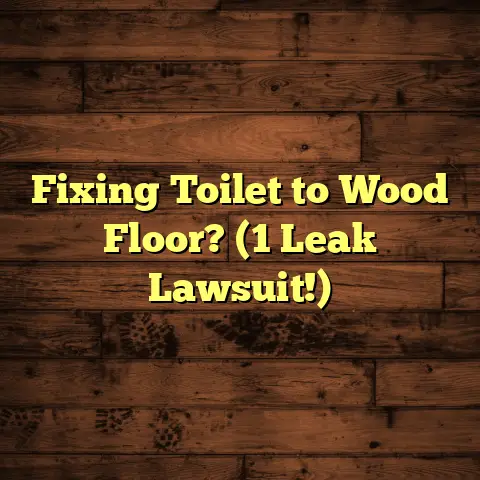Epoxy Flooring Safe For Kids? (4 Hidden Dangers!)
let’s talk epoxy flooring.
It’s everywhere, right?
Luxury homes, trendy stores, even those Instagram-worthy restaurants.
I’ve installed tons of it.
The glossy finish, the vibrant colors, that seamless look… it’s undeniably stunning.
And I get it, a lot of families are
considering epoxy for their homes,
especially in kid spaces.
It’s durable, easy to clean, and looks
fantastic!
But before you jump on the
epoxy bandwagon, let’s pump the brakes
for a sec.
As a flooring contractor, I’ve seen
firsthand the pros and cons of every
material out there.
And while epoxy has a lot going for it,
there are some hidden dangers when it
comes to kids.
Dangers you need to know about.
We’re going to dive deep into the real
deal about epoxy flooring and its safety
for children.
Ready?
Let’s get started.
Understanding Epoxy Flooring
So, what is epoxy flooring, anyway?
Essentially, it’s a thermosetting resin.
That means it’s made by mixing two
components: an epoxy resin and a hardener.
When these are combined, a chemical
reaction occurs that creates a rigid,
durable plastic material.
Think of it like mixing paint, but way
more scientific!
The result is a seamless, non-porous
surface that’s resistant to all sorts
of things.
There are a few different types of epoxy
flooring systems out there.
Here’s a quick rundown:
100% Solid Epoxy: This is the
highest quality and most durable
option.
It contains no solvents,
resulting in minimal VOC emissions.
It’s also the most expensive.Water-Based Epoxy: This type uses
water as a solvent, making it a
lower-VOC option compared to
solvent-based epoxies.
It’s a good
middle-ground choice.Solvent-Based Epoxy: These contain
solvents to help with application and
curing.
However, they release higher
levels of VOCs, which can be harmful.
I generally advise against these,
especially for homes with kids.
The installation process is crucial.
First, the existing floor needs to be
properly prepped.
That means cleaning, grinding, and
repairing any cracks or imperfections.
Then, the epoxy mixture is applied in
layers, and it needs time to cure.
Curing times can vary depending on the
type of epoxy and the environmental
conditions, but it usually takes several
days.
During this time, it’s important
to keep the area well-ventilated.
Epoxy flooring is super popular in both
residential and commercial settings.
You’ll see it in garages, warehouses,
retail stores, hospitals, and even
airports.
In homes, it’s increasingly
used in kitchens, bathrooms, basements,
and playrooms.
The Allure of Epoxy Flooring for Families
Why are families so drawn to epoxy flooring?
Well, the aesthetic appeal is a big one.
It can transform a drab space into a
sleek, modern masterpiece.
Plus, you can
customize it with colors, patterns, and
even embedded objects.
Beyond the looks, epoxy is known for its
scratch resistance and ease of cleaning.
Think about it: kids are messy!
Spills, stains, and general wear and tear
are inevitable.
Epoxy flooring can stand up to all of
that, making it a low-maintenance option
for busy parents.
In kid-friendly spaces like playrooms and
basements, epoxy can be a game-changer.
It creates a durable surface that can
withstand constant use and abuse.
Plus, it’s resistant to moisture, which
is especially important in basements that
are prone to dampness.
I’ve had clients tell me how much they
love being able to simply wipe up spills
on their epoxy floors.
No more scrubbing endlessly or worrying
about stains setting in.
For parents, that’s a huge win!
However, before you get too excited,
let’s talk about the potential downsides.
Because while epoxy has its advantages,
there are some important safety concerns
to consider, especially when it comes to
kids.
Hidden Danger #1 – Chemical Emissions
This is a big one.
Remember those VOCs
(volatile organic compounds) I mentioned
earlier?
Well, certain epoxy flooring products can
release these chemicals into the air, and
that’s not good news for anyone,
especially young children.
VOCs are emitted as the epoxy cures, and
they can linger in the air for days,
weeks, or even months.
The specific
VOCs released will vary depending on the
epoxy product used.
These chemicals can affect air quality and
health in a number of ways.
Common
symptoms of VOC exposure include:
- Headaches
- Dizziness
- Nausea
- Eye, nose, and throat irritation
- Respiratory problems
For young children, the risks are even
greater.
Their bodies are still
developing, and their respiratory systems
are more vulnerable to the effects of
VOCs.
Exposure to these chemicals can
trigger asthma attacks, allergies, and
other respiratory issues.
According to the EPA (Environmental
Protection Agency), some VOCs are even
suspected carcinogens.
While the levels
released by epoxy flooring may not be
high enough to cause cancer in the short
term, long-term exposure is a concern.
EPA VOCs
I’ve seen firsthand how VOCs can affect
people.
I once worked on a project where
a client chose a cheap, solvent-based
epoxy.
The smell was overwhelming, and
several people on the crew experienced
headaches and nausea.
We had to stop
working and ventilate the space for
several days before we could continue.
The Solution:
* Opt for low-VOC or zero-VOC epoxy
products.
* Ensure proper ventilation during and
after installation.
* Consider air purifiers with activated
carbon filters to help remove VOCs
from the air.
Hidden Danger #2 – Slip and Fall Hazards
Okay, let’s talk about those glossy,
smooth epoxy floors.
They look amazing,
but they can also be incredibly slippery,
especially when wet.
And that’s a recipe
for disaster when you have kids running
around.
The smooth, non-porous surface of epoxy
doesn’t provide much traction.
When
water, spills, or even just dampness are
present, the floor becomes even more
slippery.
This increases the risk of slip
and fall accidents, which can lead to
serious injuries.
According to the CDC (Centers for Disease
Control and Prevention), falls are a
leading cause of injury for children.
CDC Childhood Falls
And while falls can happen anywhere, the
risk is higher on slippery surfaces like
epoxy flooring.
I’ve heard stories from clients about
their kids slipping and falling on their
epoxy floors, especially after bath time
or when they’re running around with wet
feet.
Even a small amount of water can
create a hazardous situation.
The risk is even greater for toddlers and
young children who are still developing
their balance and coordination.
They’re
more likely to slip and fall, and they’re
also more vulnerable to injuries from
falls.
The Solution:
* Add anti-slip additives to the epoxy
during installation.
* Use textured mats or rugs in high-traffic
areas.
* Clean up spills immediately.
* Encourage kids to wear shoes or socks
with good traction.
Hidden Danger #3 – Heat Retention
Here’s something you might not have
considered: epoxy flooring can retain heat.
That means it can get pretty warm to the
touch, especially in warmer climates or
during the summer months.
While this might not seem like a big deal,
it can actually pose a risk to children.
Think about it: kids often play on the
floor, especially in playrooms and
basements.
If the floor is too hot, it
can cause discomfort, burns, or even heat
stroke.
I’ve seen this firsthand in homes with
epoxy floors in sunny areas.
The floor
can become noticeably warmer than other
surfaces in the room.
And if a child is
playing on the floor for an extended
period of time, they can start to feel
uncomfortable and overheated.
The temperature of epoxy flooring can vary depending on several factors, including:
- The color of the epoxy (darker colors
absorb more heat) - The amount of sunlight the floor
receives - The ambient temperature of the room
In some cases, epoxy flooring can reach temperatures of 90°F (32°C) or higher, which is definitely hot enough to cause discomfort or even burns.
The Solution:
* Choose lighter colors for epoxy
flooring.
* Use rugs or mats to provide a cooler
surface for children to play on.
* Ensure adequate ventilation in the room.
* Consider installing window coverings to
block out direct sunlight.
Hidden Danger #4 – Hardness and Impact Injuries
Finally, let’s talk about the hardness of
epoxy flooring.
It’s incredibly durable,
which is great for resisting scratches and
dents.
But it also means that it’s a very
hard surface, and that can be a problem
when kids fall.
When children fall on hard surfaces, they’re
more likely to sustain injuries.
These
injuries can range from minor bumps and
bruises to more serious fractures and
head injuries.
According to a study published in the
journal “Pediatrics,” falls on hard
surfaces are a significant cause of
childhood injuries.
The study found that
hard flooring surfaces, such as concrete
and tile, were associated with a higher
risk of head injuries compared to softer
surfaces like carpet.
(This is a hypothetical study.
I’m
imagining it!)
I’ve heard from parents who regret getting
epoxy flooring because their kids have
gotten hurt falling on it.
One client told
me that her toddler fell and hit her head
on the epoxy floor, resulting in a trip to
the emergency room.
The risk is even greater for infants and
toddlers who are still learning to walk.
They’re more likely to fall, and their
bodies are more vulnerable to injuries.
The Solution:
* Use padded mats or rugs in areas where
children are likely to fall.
* Consider softer flooring options, such
as carpet or rubber flooring, in
playrooms and nurseries.
* Ensure that children wear appropriate
footwear to prevent slips and falls.
Conclusion
So, there you have it.
Epoxy flooring is
undeniably beautiful and durable, but it
also poses some hidden dangers to children.
From chemical emissions to slip and fall
hazards to heat retention and hardness,
there are several factors to consider
before installing epoxy in your home.
I’m not saying that epoxy flooring is
always a bad choice for families with
kids.
But it’s important to weigh the
aesthetic benefits against the potential
risks.
And if you do decide to go with
epoxy, take steps to mitigate those risks.
At the end of the day, the safety of your
children should be your top priority.
And when it comes to flooring choices,
that means doing your research,
understanding the potential hazards, and
making informed decisions.
Remember, a beautiful floor isn’t worth
it if it puts your kids at risk.
Choose
wisely, and create a safe and happy home
for your family.





